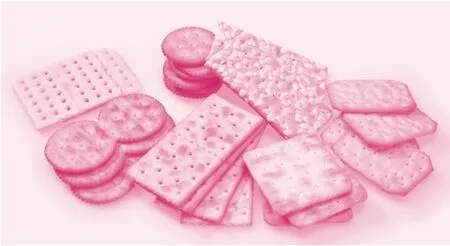The Dangers of the Appearance-Driven Diet
2017-09-08ByJennyChen
By Jenny Chen
The Dangers of the Appearance-Driven Diet
By Jenny Chen
A new study found that when people focus on looks, they’re less tuned in to the body’s signals of hunger and fullness. 一项
新的研究发现,如果人们专注样貌,就会忽略身体的饥饱信号。Growing up I was terrified of being fat. My mother made disparaging1disparaging毁谤的,轻蔑的。remarks about girls on TV who were slightly chubby2chubby圆胖的,丰满的。and the teen magazines I read were endlessly obsessed with losing weight. On the eve of my first year in college, I learned of the Freshman 15 in one of those teen magazines—the apparent inevitability that every freshman would gain 15 pounds in their first year in college. I was even more horrified when I arrived at school and found myself facing an endless buffet of desserts and cheesefilled entrees. I suddenly had to rely on my own self-control to stop myself from eating ice cream for breakfast. I didn’t trust myself. I never had.
[2] That’s when I turned to the world of glossy fitness magazines and calorie counting. I put myself on a stricter and stricter diet of endless running and shrinking portion sizes. But that wasn’t always enough—my body started rebelling with gnawing hunger and debilitating exhaustion. Whenever I felt like I was tempted to break my strict regime, I would turn to other people: I would look at people who were thinner than me as inspiration to get even thinner myself, and I would look at people who were bigger than me as inspiration for what not to look like. I became obsessed with appearances.
从小到大我一直害怕变胖。我妈只要在电视上看到稍微胖点儿的女孩,就会冷嘲热讽几句,我读的那些青少年杂志也总是不厌其烦地谈论减肥。就在上大学前夕,我从某本青少年杂志上了解到“新生15磅”这样的说法——每名新生必会在大一那一年增重15磅。来到学校后,我发现这里的甜点和富含奶酪的主菜应有尽有,心中更是恐惧。我这下不得不依靠自制力来阻止自己早餐吃冰激凌了。但我对自己没信心。我压根儿就不行。
[2]这时,我转而求助一本本时尚健身杂志,并开始计算食物卡路里。我对自己的饮食控制越来越严格,不断增加消耗、减少摄入。但这并非就行了——身体开始剧烈反抗,用饥饿感啃噬我,用疲惫感削弱我。每当感觉自己要禁不住诱惑放松标准,我就会求助他人:我会看比我瘦的人,激励自己要更瘦,还会看比我胖的人,提醒自己不要和他们一样。我越来越痴迷于保持身材。
[3] Two years later though, things started getting out of control. I had lost so much weight that my advising dean wanted me to take time off of school. When I started trying to recover and eat more I found myself in a nightmarish3nightmarish可怕的,恶梦似的。spiral of binging and purging that I couldn’t get out of. If I couldn’t trust myself with food before, I was actually scared of food now.
[4] New research may give a clue to how things spiraled out of my control, at least in part.
[5] Researchers from the Netherlands published a study in the Journal of Experimental Social Psychology that suggested that focusing on appearance could affect a person’s sensitivity to their internal satiety cues.

[6] “We found that focusing on how you look may hinder how you listen to your body’s hunger fullness cues and how you adjust your food intake,” said Evelien van de Veer, the paper’s lead author.
[3]不过,两年后,情况开始失控了。我体重减得太厉害,以至于教务主任让我休学一段时间。当我努力恢复,试图多吃些时,却陷入暴食和清肠的可怕漩涡中无法自拔。如果说以前我是不相信自己能控制吃,现在其实是害怕吃了。
[4]事情怎么就在我身上变得一发不可收拾了?新的研究成果或许能解释一二。
[5]荷兰的研究人员在《实验社会心理学杂志》上发表的一份研究报告称,专注样貌会影响一个人对自身内在饱腹感的敏感程度。
[6]“我们发现,专注于自己的样貌会妨碍一个人倾听自己身体发出的饥饱信号,进而影响对摄取食物的调整。”报告的第一作者埃韦利恩·范德维尔如是说。
[7] Van de Veer and her team recruited 113 participants and conducted two experiments for their study. In the first experiment, researchers told participants they were participating in a milkshake taste test. They divided the participants into two groups. Both groups were given a milkshake to drink but only one group of participants had a mirror placed on their desk. Within each of these groups, half of the participants drank a high-calorie milkshake while the other half drank a low-calorie milkshake, but they were not told which one they were drinking. Fifteen minutes after the milkshake, the participants were asked to go into a room to watch a movie on a computer. There was a bowl of M&M’s4美国的巧克力豆品牌。placed next to the computer. The researchers found that the participants who drank the high-calorie milkshake while looking at the mirror consistently ate more M&M’s than the participants who drank the milkshake without looking into a mirror.
[8] In the second experiment, researchers tested two groups of female participants. One group came before lunch (the “hungry condition”) and the other half came after eating a filling lunch (the “satiety condition”). Half of the participants in each condition were asked to look at advertisements depicting thin models. They then participated in a cracker taste test, did 15 minutes of a filler task, and then the experimenter told the participants that she would leave the crackers on the table so that they could help themselves if they wanted to. While people in the “hungry condition”ate about the same amount of crackers whether they saw the models or not, research found that those who were in the “satiety condition” tended to eat more crackers if they had looked at the advertisements beforehand.
[7]研究中,范德维尔和她的团队招募了113名志愿者,进行了两次实验。第一次实验,志愿者被告知参与的是一项奶昔味道测试。志愿者被分成两组,每组品尝一种奶昔,不同的是只有一组桌上放了一面镜子。两组内部,一半志愿者喝高卡路里奶昔,另一半喝低卡路里奶昔,但没有人知道自己喝的是哪一种。喝完奶昔15分钟后,志愿者被要求进入房间在电脑上看电影。电脑旁边放着一碗M&M’s牛奶巧克力豆。研究人员发现,喝高卡路里奶昔的志愿者中,边看镜子边喝的与没看镜子喝的相比,吃的巧克力豆更多,且一贯如此。
[8]第二次实验,研究人员测试了两组女性志愿者。一组没吃午饭(处在饥饿状态),另一组饱餐了一顿(即处在饱腹状态)。每组中,一半志愿者被要求观看描述瘦模特的广告。随后,志愿者参与了一项饼干味道测试,15分钟填一个表,工作人员告诉志愿者,她会把饼干留在桌子上,他们想吃可以自己拿着吃。研究人员发现:处在饥饿状态的志愿者,不管有没有看模特广告,吃的饼干基本一样多;处在饱腹状态的志愿者,之前看过广告的往往吃的饼干更多。
[9] Researchers drew upon past research on self-objectification and distracted eating to explain why people in the experiments were less likely to sense fullness if they were focused on appearance. In a study from 2006, women who were preoccupied with how others perceived their bodies (a state psychologists call self-objectification) were more likely to be distracted and unable to focus on cognitively challenging tasks. Previous studies also found that people who were distracted while eating were less likely to sense their body’s internal satiety cues. Thus, researchers suggested in the study that people did not adjust their intake according to fullness cues if they were focused on appearance because they were distracted from sensing those cues.
[10] Van de Veer said that the experiment was unique because it tested how participants adjust their food intake over two separate episodes of consumption. “A lot of experiments look at the effects of external stimuli on one moment of consumption but we wanted to show there are effects [of focusing on appearance] from one moment to one moment. How you adjust what you eat from moment to moment is important because that makes up your total food intake,” she said.

[9]研究人员利用过去有关自我物化和分神进食的研究来阐释这两次实验的发现,即为什么实验参与者如果专注于样貌就不太可能有饱腹感。2006年的一项研究显示,过于在意他人对自己外表观感(即心理学家所说的自我物化状态)的女性更可能注意力不集中,无法专注于具有认知挑战性的任务。之前的多项研究也发现,那些吃东西时注意力不集中的人,不太可能关注自身的内在饱腹感。因此,研究人员认为,在这一研究中,如果志愿者专注样貌,就不会根据饱腹感调整摄食,因为他们的注意力被分散,没有注意饱腹感。
[10]范德维尔表示,他们的实验是独一无二的,因为测试了两种不同的进食情况下,志愿者如何调整自身的食物摄入。范德维尔说:“许多实验看的是进食的某一刻外部刺激的影响,但我们想表明,专注于样貌时时刻刻都有影响。如何随时调整摄食很重要,因为这决定了总体摄食情况。”
[11] Jenni Schaefer, eating disorder activist and author of Life Without Ed5= Eating Disorder。: How One Woman Declared Independence from Her Eating Disorder and How You Can Too, says that this research confirms something that people in the eating-disorder community have known for a long time. “Sometimes you’ll hear people with eating disorders say they’re like a walking dead. There’s really no connection to their hunger and fullness cues,” Schaefer said. “Looking back at my own eating disorder ... I knew when I was really really hungry and I knew when I was really really really really stuffed. But I didn’t know anything about those hunger fullness cues in between the far extremes.”
[12] But the research from the Netherlands doesn’t just apply to people with eating disorders, said Evelyn Tribole, the registered dietitian and nutrition counselor who pioneered the Intuitive Eating program in 1996. Chronic dieters also suffer from the negative impacts of focusing on appearance. “I see this over and over again—people eat according what they think celebrities or fitness models are eating,” Tribole said. “Then they begin to ignore their hunger fullness cues and even stop feeling them after awhile.”
[11]詹尼·谢弗,进食障碍知识的积极推广者,也是《与进食障碍分手》一书的作者。她认为,范德维尔的研究确证了长期以来在进食障碍群体中众所周知的一些东西。“有时,你会听到进食障碍患者说自己好像行尸走肉。根本不知道自己是饿还是饱。”谢弗说,“回顾我自己进食障碍的经历……我只在饿极了和饱极了的时候有感觉。但在这两个极端感觉出现之前,我感觉不到饥饿和饱腹。”
[12]但伊夫琳·特里博尔表示,荷兰研究团队的这一研究不仅可以适用于进食障碍者。特里博尔是注册营养师和营养顾问,早在1996年就率先创立了直觉饮食项目。长期节食者也遭受着专注样貌所带来的负面影响。“我一次次目睹这样的情况,人们自以为名人或健美模特都吃些什么,自己就也照着吃。”特里博尔说,“随后,他们开始忽略身体的饥饱暗示,一段时间之后,甚至根本没有感觉了。”
[13] Schaefer hopes that this research will prompt the dieting industry to help people break the cycle of endless dieting. “What’s awesome about this study is that maybe the dieting industry will take note of this and help people make lifestyle changes as opposed to just going on diets, and change their marketing from being [based on appearance],” Schaefer said.
[14] However, Evelyn Attia, director of the Center for Eating Disorders at Columbia University, says that it’s unlikely that one study will inspire that kind of sweeping6sweeping彻底的,广泛的。change.
[15] “I don’t think the verdict is out yet. I’d love to see the study replicated and tested across a variety of foods and images,” she said. “If it turns out that the study can be further substantiated it begins to suggest that outside elements in our environment other than food affects our eating habits.” ■
[13]谢弗希望范德维尔团队的研究可以促使节食产业帮助人们打破无休止节食的不良循环。她说:“这项研究的好处是,节食产业可能会加以关注,进而帮助人们改变生活方式,而不是一味节食,并改变该行业[基于样貌]的营销模式。”
[14]但是,哥伦比亚大学进食障碍研究中心主任伊夫琳·阿蒂亚认为,仅凭一项研究不太可能激发那样的行业巨变。
[15]“我认为自己的判断并未过时。我乐见这一研究能够不断复制,以各种各样的食物和影像来验证。”阿蒂亚说道,“如果这项研究能够进一步得到证实,那就可以表明,除了食物,环境中的外部因素也会影响我们的饮食习惯。”□
为 貌 择 食 的 危 险
文/珍妮·陈(音译) 译/管利民 审订/辛勤
(译者单位:北京市朝阳区委办)
